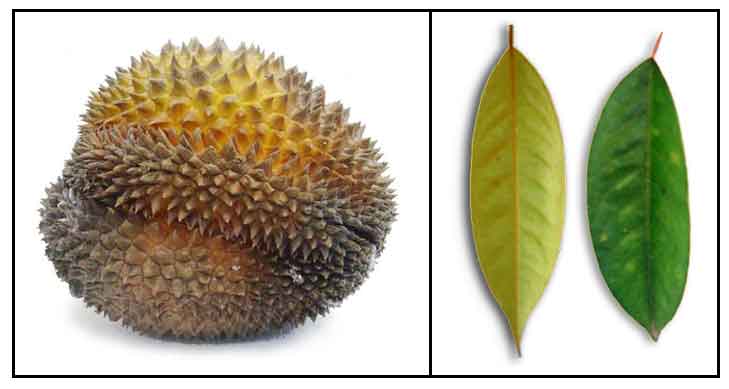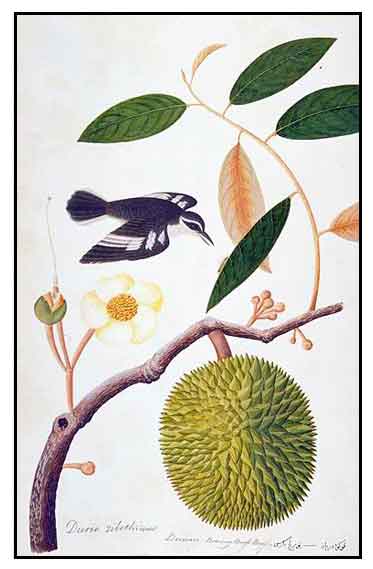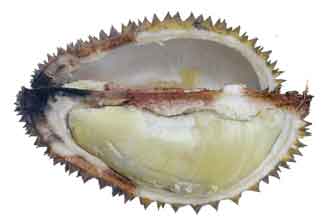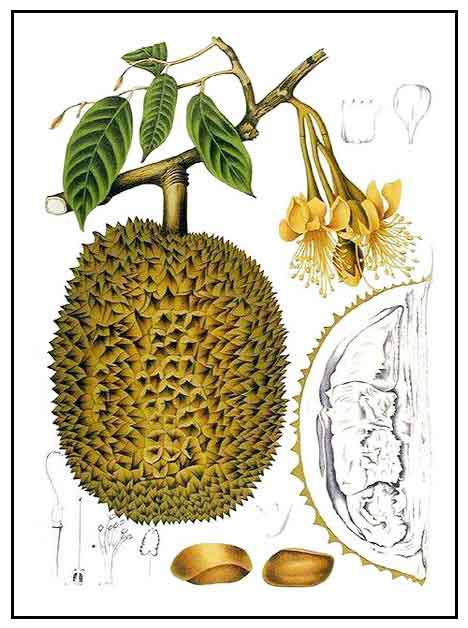|  Plant pearls Plant pearls
- In Southeast Asia, considered
the "King of Tropical Fruits."
-
The durian is the edible fruit f several tree species belonging to the genus Durio. There are 30 recognized species, native to Indonesia, Malaysia, the Philippines, and Thailand, at least nine of them producing edible fruit.
- Durio zibethinus, native to Borneo and Sumatra, is the only species available in the international market. Ir ha over 300 named varieties in Thailand and 100 in Malaysia. (54)
- Etymology: The name 'durian' derives from the Malay word 'duri/, meaning thorn, referring to the numerous prickly
thorns on its rind. (543)Botany
Durian is a tree that grows to a height
of 20 meters or more. Leaves are dark green, smooth and shiny above,
cinnamon-colored and scaly beneath, oblong to obovate-oblong, about 15 to 25 centimeters long, 5 to 9 centimeters wide. Flowers
are white to yellowish-white, about 7.5 centimeters in diameter, with a pouch-like calyx. Fruit is globular,
very large, 15 to 25 centimeters long, covered by a hard shell with stiff, sharp spines, weighing as much as 3 kilos or more.
Shell breaks into five parts to which the flesh adhere. In each section of the fruit, there are 2
to 6 very large seeds covered by the flesh (aril). The flesh is
soft and whitish, with the consistency of soft cheese, with
a characteristic unpleasant rank and repugnant odor of bad smelling cheese. The seeds are eaten, either boiled
or roasted.
Distribution
- Introduced.
- Native to Borneo and Sumatra.
-
Cultivated for its highly prized fruit.
- Not known to exist in a wild state in the Philippines.
- Found in Agusan, Butuan, Lanao, Zamboanga, Cotobato, and Davao Provinces in Mindanao, and in the Sulu Archipelago.
- Also occurs in Indo-China, the Malay Peninsula, Java, Sumatra, Borneo, Celebes, and the Moluccas mostly in cultivation.
C onstituents onstituents
• The odor of the flesh believed to be due to indole compounds
which are bacteriostatic.
• Study identified the three strongest sulfury durian odorants
and one non-sulfurous odorant with the highest odor impact.
• Study on the fruit odorants identified ethyl 2-methylbutanoate to have the highest odor impact among non-sulfurous odorants in durian. (see 40 below: What causes the odor)
• The fruit yields considerable amounts of phenolics, flavonoids, and carotenoids.
• Study for volatile compounds identified 108 compounds, including 48 esters, 18 sulfur compounds, 16 carbonyl compounds, 11 alcohols, 7 hydrocarbons, and 7 miscellaneous components. (see study below) (20)
• Study for proximate composition and pasting properties of durian seed flour. Whole durian seed flour (WDS) yielded 6.5% water, 6.0% protein, 3.1% ash, 0.4% fat, 10.1% crude fiber, and 73.9% carbohydrate. Dehulled durian seed flour (DDS) yielded 6.6% moisture, 7.6% protein, 3.8% ash, 0.4% fat, 4.8 % crude fiber, and 76.8% carbohydrate. (29)
• Study of wood bark extract yielded two new triterpenoids,
methyl 27-O-trans-caffeoylcylicodiscate (1) and methyl 27-O-cis-caffeoylcylicodiscate (2), a new phenolic, 1,2-diarylpropane-3-ol (3), and seven known compounds, fraxidin, eucryphin, boehmenan, threo-carolignan E, (−)-(3R,4S)-4-hydroxymellein, methyl protocatechuate, and (+)-(R)-de-O-methyllasiodiplodin. (39)
- Phytochemical screening of crude extract of wood bark yielded
phenols, alkaloids, steroids, tannins, terpenes, saponins, and flavonoids. GC-MS analysis revealed presence of 2, 6, 5, and 4 compounds in fractions 1-4 respectively. The major chemical constituents identified were (Z)-9-octadecnoic acid (oleic acid) (91.36%), (E)-9-octadecenoic (elaidic acid) (56.10%), (Z)-6-octadecenoic acid (petroselinic acid) (41.19%), and (E)-9-octadecenoic acid (elaidic acid) (42.20%) in fractions 1-4 respectively. These major constituents provide biological and therapeutic properties. (48)
Properties
- Fruit is considered tonic, operative, depurative, and vermifuge.
- Possess a repugnant odor that
bans it from hotel lobbies and rooms.
- The odor has two distinct notes: a delicate note caused by esters, and another onion-like note caused by thiols and thioesters.
(33)
What causes the odor
- While some regard its aroma as a pleasantly sweet fragrance, many find the aroma overpowering and unpleasant, even disgusting, akin to rotten onions, turpentine, or sewage. (54)
-
A Singaporean study sought to identify the cause of the pungent durian smell. The team mapped the genome of the durian variety "Mao Shang Wang." Analysis revealed the durian genome comprises approximately 46,000 genes (almost double that of humans). Study identified a class of genes called MGLs (methionine gamma lyases) that regulates the production of odor compounds, VSCs (volatile sulfur compounds). VSC production is turbocharged in durian fruits. (40) (also see study below: 41)
 Nutritional
Facts Nutritional
Facts
• Serving size: 1 - cup, chopped or diced (8.6 oz)
• Calories 357
• Total Fat 13.0 g
• Cholesterol 0 mg
• Total Carbs 65.8 g
• Fiber 9.2 g
• Protein 3.6 g
• Calcium 14.6 mg
• Potassium 1059.5 mg *
Caution !
• High Potassium Content: As a potassium-rich
food it could be a good fruit to supplement potassium needs of
patients on diuretic therapy. However, it's potassium content should
be of concern in patients with kidney failure or varying degrees of
renal impairment or those already taking other forms of potassium supplementation
or potassium-sparing diuretics.
Parts used
Fruit, leaves, and root.
Uses
Edibility
· Fruit is a good source of carbohydrates, with significant amounts of protein and vitamin B and C. Pulp is eaten raw, cooked as vegetable, frozen or dried. In Indonesia, pulp is fermented for a side dish or mixed with fleshy arils with rice and sugar for a local dish called lempong. (21)
· Seeds, boiled or roasted, are eaten as nuts.
· Flower petals, young leaves, and shoots are edible. (36)
Folkloric
· Decoction of
root and leaves taken for fevers.
· Leaves are used in medicinal baths for jaundice.
· The juice is used in a solution for bathing the head of a patient
with fever.
· In Java, fruit walls used externally for skin problems.
· In Malaya, decoction of leaves and roots used as febrifuge.
· Leaf juice applied on head for fever.
· Decoction of leaves and fruits used for swelling and skin diseases.
· Flesh used as aphrodisiac.
· In China, decoction of leaves and
roots used for fever. Used for colds, phlegm. Leaves used in medicinal
baths for patients with jaundice. Ash of burned rind taken after childbirth.
Used to improve sexual function.
· In Malaysia, leaf juice applied
to head for fever.
· A Malay prescription for fever
is a decoction or poultice of boiled roots of Hibiscus rosa-sinensis,
Durio zibethinus, Nephelium longan, Nephelium mutabile and Artocarpus
integrifolia. source
Others
· Dried rinds burned
as fuel and used to smoke fish.
· Ash used to bleach silk.
· Timber: Heartwood is dark red, relatively durable and used for interior construction, cheaper types of furniture and packing cases. (21)
 Studies Studies
• Lipid Entrapment / Lipid
Lowering Effect / Fruit Hulls: Study evaluated the lipid entrapment property of a polysaccharide gel extracted from fruit hulls of durian. Results suggest that
PG from fruit-hulls of durian may be a potential dietary fiber/ medicinal
supplement for a blood lipid / cholesterol lowering effect. (3)
• Durian-Alcohol Combination: Study investigated the adverse, and sometime lethal, effect of ingesting durian while imbibing alcohol with its Disulfiram-Ethanol type reaction arising from inhibition of aldehyde dehydrogenase (ALDH). (See Toxicity below) (4)
• Immunomodulatory / Antibacterial: Polysaccharide gel from the fruit rind of D zibethinus has been characterized to be a pectic polysaccharide with immunomodulating and antibacterial activities. (13)
• Hyperthermic
Effect / Paracetamol Interaction: Believed
to have body-warming properties with concerns on consumption with paracetamol.
Rat study showed no significant body temperature elevation. Rats receiving
a durian-paracetamol combination showed a significant drop in body temperature.
No mechanism for toxicity was identified. (5)
• Antibacterial
/ Wound Healing Effect: Polysaccharide gel extracted from fruit-hulls of durian was prepared as a preparation of dressing film for use in the treatment of full-thickness excisional wounds in swine. Results showed the PG dressing film treated wounds showed showed a beneficial effect on wound healing with more rapid wound closure. (8)
• Bactericidal Effect
/ Wound Healing: Bactericidal
effect of polysaccharide gel was clearly demonstrated against S. aureus
and E. coli. Study showed accelerated wound healing. (11)
•
Phenolic Content
/ Antioxidant Effect: Study
showed the durian cultivars' high bioactivity and total polyphenols
were the main contributors to the overall antioxidant capacity and provides
a source of nutritional supplement. (10)
• Fruit-Hulls Antimicrobial Activity: PG inhibited the growth of 2 bacterial strains tested: S aureus and E coli. The yeast strains were resistant. (14)
• Physiochemical Properties / Storage: Study on ambient and refrigerated storage showed the pulp can be stored for 21-days, after which off-flavor develops and the green aroma becomes too intense and renders the pulp unacceptable. (15)
• Antioxidant / Phytochemicals: Study showed caffeic acid and quercetin were the dominant antioxidant substances in durian. Ripe durian showed high bioactivity and the total polyphenols were main contributors to the overall antioxidant property.
• Wood Bark / Synergism with Penicillin G: Study showed the synergistic activity of a chloroform extract of Durio zibethinus wood bark with Penicillin G against Staphylococcus aureus. Although the effect was mild, authors suggest it is possible that DZ can reverse resistance and potentiate the effect of common penicillin against resistant Staphylococcus aureus. (17)
• Aroma Volatile Profile / Pulp: Study analyzed the aroma volatile compounds of the Philippine "Puyat" durian. The pulp produced 22 volatiles composed of 15 esters, 6 sulfurs, and 1 thioacetal. Ethyl propanoate, ethyl octanoate, propyl propanoate, ethyl 2-methyl butanoate and diethyl disulfide were the major compounds identified. (18)
• Major Odor Active Compounds: Dilution analysis applied on the volatile fraction isolated 44 odor-active compounds in the flavor dilution (FD) factor range of 1-16384, identifying 41, of which 24 had not been reported before. High FD factors were found for ethyl (2S)-2-methylbutanoate (fruity; FD 16384), ethyl cinnamate (honey; FD 4096), and 1-(ethylsulfanyl)ethanethiol (roasted onion; FD 1024). Among the highly volatile compounds screened by static headspace gas chromatography–olfactometry, hydrogen sulfide (rotten egg), acetaldehyde (fresh, fruity), methanethiol (rotten, cabbage), ethanethiol (rotten, onion), and propane-1-thiol (rotten, durian) were found as additional potent odor-active compounds. (See abstract for further FD details.) (19)
• Volatile Compounds / Taste and Odor: Study for volatile compounds identified 108 compounds. Acetoin, ethyl 2-methylbutanoate and diethyl disulfide were predominant. Esters and sulfur compounds were considered responsible for durian's strong fruity and sulfury odors, while ketones, especially acetoin, likely contribute to its creamy flavor. (see constituents above) (20)
• Antimicrobial: Study evaluated the antimicrobial potential of durian fruit against human pathogens. Antibacterial activity was more pronounced in the fresh durian fruit sap. Dose dependent variations in antimicrobial activity was noted. Extracts also showed good antifungal activity. Results suggest potential antimicrobial compounds in durian fruits. (22)
• Aphrodisiac: Study evaluated compound (3-β-hydroxy-21-Normethyl-19-vinylidenylursane), isolated from a petroleum ether extract, for aphrodisiac activity in sexually active male mice. Results showed significant aphrodisiac activity and suggest further study to identify biologically active constituents. (23)
• Antibacterial / Rinds and Seeds: Study evaluated methanolic crude extracts from seeds and rinds of durian for antibacterial activity against hospital isolates of E. coli and Staphylococcus aureus. Durian seed and rind showed greater inhibition on E. coli bacterium, greater than control chloramphenicol. (24)
• Antifungal and Wound Healing Effects Compared to Nystatin: In vivo study compared the antifungal and wound healing effects of DZ seeds extract versus Nystatin on full skin thickness wounds in rabbits. The Inflammatory Phase Grading System and Fibroplasia Phase Grading system showed better antifungal and wound healing effect for Nystatin. (25)
• Antioxidant Phytochemicals: Study evaluating the antioxidant phytochemical constituents of fruit extracts from four varieties of durian yielded phenolic contents in the range of 690.62-998.29 mg/L, total flavonoids of 211.36-220.34, vitamin C of 18.87-25.1 mg/L. Caffeic acid and quercetin were the dominant antioxidant components. (26)
• Absorption of Basic Blue: Study evaluated the ability of durian peel to remove Basic blue 3 (BB3) from aqueous solution. Absorption was found to be concentration dependent, the percentage uptake increasing with increase in temperature. Absorption was found to be endothermic. (27)
• Effects of Polysaccharide Gel from Rind as Feed Supplement: Study evaluated a polysaccharide gel (PG) from the rind of durian as feed-supplement diet on body weight, immune stimulation, total bacteria and Salmonella and cholesterol levels in broilers. Results showed health promotion benefits in broiler chickens as an antibacterial, immunostimulant and cholesterol-lowering effect. (28)
• Proximate Analysis of Durian Seed Flour: Study on proximate analysis of durian seed flour showed it to have great potential in food industry because of its high dietary fiber content and suitability when used as dough and as thickening agent. (see constituents above) (29)
• Biosorbent / Seeds / Methyl Orange Dye: Study of durian seed powder showed a low cost and high efficiency biosorbent to reduce Methyl Orange dye in solution. (31)
• Anti-thrombocytopenic Effects: Study evaluated the anti-thrombocytopenic effects of durian aril in hydroxyurea-induced thrombocytopenic albino rats. There was a significant increase in platelet count after the administration of lyophilized D zibethinus. (32)
• Technical Factors in Wine Fermentation: Study of technical factors influencing durian wine fermentation showed: ration of amylase 0.4 ml/100 g, pectinase 0.04 ml/100 g puree for best clearance of juice during glucosidation; the more pectinase used, the more methanol is formed; pulp ration 35%, soluble dry matter 23%, pH 3.5. Optimal conditions for enzyme activity during glucosidation were as follows: temperature 65°C, pH 4.2, amylase 0.4%, hydrolysis time of 60 minutes, and fermentation stopped at 9th day. (33)
• Antidiabetic / Antihypercholesterolemic / Fruit Peels: Study of durian fruit peel extracts for antidiabetic and antihypercholesterolemic activities showed 50.19 ± 3.66% reduction of blood glucose and 35.82 ± 5.00 % reduction of cholesterol levels at t00 mg/kbw dose. (37)
• Antimicrobial Compound / Fruit Pulp: Study of a chloroform extract of fruit pulp of Durio zibenthinus isolated 7,8-dimethoxy-13,13-dimethyl-2,13- dihydro-3H-Pyrano[5,6-c]quinolin2-one, a compound that showed significant antibacterial and antifungal activity against microorganisms tested. (38)
• Biologic Processes Involved in the Durian Odor: Study focused on analyzing the biological processes related to durian odor. VSCs (volatile sulfur compounds) have been identified as major contributors to the durian smell. Analysis suggested a distinct role for MGL (methionine y-lyase) genes in the fruit, where the genes are significantly upregulated. (41)
• Phytosterol from Agrowaste / Seed: Phytosterol from Durian seed has been discovered from screening work using mass spectrometer. Benefits of plants sterols have been demonstrated in numerous studies. It has been shown to reduce plasma cholesterol, and, thus, may have beneficial effect by reducing atherosclerosis and coronary heart diseases. Preliminary screening of methanol extracts of seeds of D. zibethinus has yielded phytosterols. The results promote utilization of durian seeds as a functional ingredient in food products through standardized extract based on phytosterol content. (42)
• Effect on Malondialdehyde as Biomarker of Oxidative Stress: Study evaluated the effect of durian consumption on malondialdehyde (MDA) in plasma as oxidative stress marker in Sprague Dawley rats. Results showed MDA level significantly decreased in week 1 and 2. However, MDA dramatically increased exceeding control group level in week 3. (43)
• Mucilage / Potential as Tablet Binder / Seed: Study showed the mucilage obtained from Durian and Rambutan seeds has potential for used as tablet binder. (44)
• Antibacterial / Bacterial Endo-Symbiont / Leaves: Endophytes provide an abundant reservoir of bioactive metabolites of medicinal exploitation. Study isolated an endophyte from the leaves of DZ, Endophytic crude extract (DZLM) was evaluated for antimicrobial activity against seven human pathogenic ATCC strains. The DZLM showed highest MIC and MBC of 250 µg/ml and 500 µg/ml, respectively, against Bacillus subtilis and Staphylococcus aureus. At MIC of 250 µg/ml the DZLM showed significant inhibition zone against ATCC strains comparable to gentamicin. The biologic activity of endophytes residing in DZ leaves has pharmacologic potential and may provide lead in the pursuit of new biological drug sources. (45)
• Lipid Entrapment Property / Polysaccharide Gel / Fruit Hulls: Study evaluated the lipid entrapment property of polysaccharide gel extracted from fruit hulls of durian by in vitro semi-permeable membrane dialysis technique using both cellulose membrane and gut sacs of dissected jejunum of rat. Results suggest durian PG is able to entrap lipids and has potential for use as medicinal dietary food for lipid controlling patients. The in vitro study using cellulose semi-permeable membrane dialysis method may be applied for preliminary evaluation of polysacchride effecting lipids absorption. (46)
• Antimicrobial / Essential Oil of Peels: The edible part of the fruit is only about 33% while the non edible parts, seeds and peels are waste products contributing to environmental pollution. Study evaluated the percentage yields and volatile compounds from methanol extracts and essential oils of peels of four varieties of durian. GC-MS study showed the major essential oil compounds of the four varieties was butanoic acid. Also present in the four varieties were 1-tridecene, 1-pentadecene, and 1-heptadecene. The D168 variety showed strong activity against three bacteria viz. Bacillus subtilis, Staphylococcus aureus, and Pseudomonas aeruginoa. (47)
• Effect on Functional Constipation / Rind Polysaccharide: Study evaluated the effects of DZMP (Durio zibethinus Merr. rind polysaccharide) in a constipation model in Sprague Dawley rats and its effect on gut microbiota. Durio zibethinis rind polysaccharide was found to promote gut hormones associated with intestinal peristalsis. DZMP reversed abnormal levels of SCFAs (short-chain fatty acids) and gut flora in constipated rats. A number of gut bacteria were found to be closely related to constipation. DZMP is a safe and potential agent to treat constipation (49)
• Immune Regulating Function / Intestinal Flora and Proteomics / Rind: Study evaluated the immune regulating effects of DZ rind polysaccharide through proteomics and intestinal flora in a cyclophosphamide immunosuppressive mouse model. Study showed the thymus and spleen indices at high-dose DZMP were significantly increased. Contents of IL-2, IL-4, IL-6, and TNF-α were significantly increased (p<0.001). Activities of ACP, LDH, SOD, and total antioidant capacity were increased in the serum. In the liver, CAT activity was increased while MDA content was decreased. Proteomics study showed that the drug group could signficantly increase low-affinity immunoglobulin receptor III protein and PKC-a. These proteins were likely involved in the metabolic pathways of autoimmune thyroid disease, Staphyococcus aureus infection, and NF-kB signaling pathway. Intestinal microbiota studies showed increase in SCFAs content along with abundance of beneficial bacteria. Results showed that DZMP might play a beneficial role in immune regulation by improving the intestinal flora. (50)
• Antidiabetes / Antioxidant / Root: Study evaluated the treatment of diabetes by reduction of gastrointestinal glucose absorption through the inhibition of α-glucosidase enzyme using root extracts of D. zibethinus. The root extracts showed DPPH radical scavenging activity with IC50s of 273.58, 139.53, and 166.84, respectively. The ethanol extract showed most active antioxidant activity and highest inhibitory activity against α-glucosidase enzyme. The ethanol extracts also showed highest levels of phenolics and flavonoid contents. (51)
• Bacterial Endophyte / Radical Scavenging / Antidiabetic: Endophytes have been found to be remarkable sources of bioactive metabolites. Study isolated endophytes from DZ leaves. 16s rRNA partial genome sequencing was used to identify the endophyte Cronobacter sakazakii. Antidiabetic assay demonstrated a dos-dependent percentage inhibition of the enzymes. Results showed DZLM is a wellspring source of antioxidants and antidiabetic agents. (52)
• Gold Nanoparticles / Antimicrobial, Antioxidant, Anticoagulant: Study reports on an eco-friendly, efficient green synthesis of gold nanoparticles (AuNPs) using DZ extract as reducing and capping agent. The AuNPs showed remarkable antimicrobial, antioxidant, and anticoagulant activities. (53)
Toxicity
• Durian with Alcohol / Inhibition of Aldehyde Dehydrogenase:
. Phytochemical screening identified phenols, carbohydrates, alkaloids, flavonoids, steroids, mucilage and glycosides. have been made of believed adverse and sometimes lethal effects
of ingesting durian while drinking alcohol. The scientific basis has
not been established. A study showed a dose-dependent inhibition of
yeast ALDH (aldehyde dehydrogenase) by sulphur-rich fruit extract. Results
support the role of durian fruit's high sulphur content in its ALDH-inhibiting
property providing insight into the disulfiram-ethanol-like reaction
with the simultaneous fruit ingestion and alcohol consumption. (4)
Availability
- Cultivated for its fruit.
- Extracts and tinctures in the cybermarket.
|


 Plant pearls
Plant pearls onstituents
onstituents Nutritional
Facts
Nutritional
Facts  Studies
Studies 

